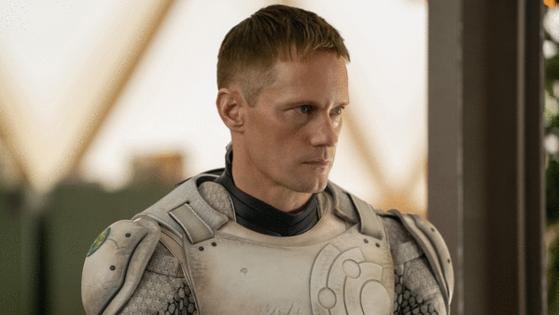'Murderbot' review: A robot turns sentient and … decides to watch a lot of TV
Published in Entertainment News
A cyborg providing security to a corporation’s workers hacks into its own system and becomes sentient in the droll 10-episode sci-fi Apple TV+ comedy “Murderbot,” based on “The Murderbot Diaries” book series by Martha Wells. Alexander Skarsgård stars as the Security Unit in question. People call them SecUnits for short, but Murderbot is the name this particular robot has given itself after successfully shutting down its internal module that ensures it obeys every and any human command. Unsure what to do with this newfound freedom, and reluctant to tip off the company that it’s become ungovernable, for now Murderbot pretends to be its usual robotic self while it figures out what’s next. Meanwhile, we hear its inner monologue, which is filled with snarky assessments of the annoying humans in its vicinity. Did I mention the show is a comedy?
SecUnits have no gender, but it’s tempting to refer to Murderbot as “he” because instead of casting an androgynous actor, show creators Chris Weitz and Paul Weitz (“About a Boy,” “Mozart in the Jungle”) went with Skarsgård, who presents as male on screen. But in the books, Murderbot is “it” — both to itself and everyone who interacts with it. So “it” it is.
This is a vision of the future where planets are corporate entities, and exploitation — extracting anything useful from said planets — is the name of the game. Murderbot is an older model, so it’s sent here or there, stoically overseeing rowdy, low-level miners. But the first assignment, post-awakening, is different. Murderbot is tasked with guarding a bunch of hippie scientists hailing from a rare “non-corporate planet with a communal governing system” who it immediately realizes are not the “usual greedy psychopaths” it encounters. Off they go on a research trip to a planet otherwise uninhabited by humans, where life-and-death misadventures and petty bickering ensue. Eventually, Murderbot’s secret is revealed and after initially freaking out, the human companions decide to risk it all to help Murderbot carve out its own existence apart from the corporation to which they’re all beholden.
Childlike, sardonic and increasingly confused by its growing (and suddenly non-corporate mandated) sense of attachment to its human clients, Murderbot is unsure how to respond when, early on, the team’s leader (played by a terrific Noma Dumezweni) treats it not as a piece of technology, but as a fellow living being deserving of compassion and respect. Even her hilariously annoying colleagues think she’s anthropomorphizing this SecUnit and are skeptical of her insistence that they treat it as more than just a household appliance that exists to save their skin when the need arises. It should come as no surprise that the group is terrible at risk assessment. When Murderbot senses a threat and instructs everyone to come back inside the safety of the pod, they just stand there, slack-jawed. They are idealistic — lovers not fighters — and therefore terribly unsuited for the dangers of this unexplored planet.
Early in the expedition, Murderbot is just going through the motions. When it’s not securing the perimeter or saving one pesky human or another, it spends hours watching TV, and there is a lot at its disposal. “With my governor module hacked, I could now access the combined feed of entertainment channels on the company’s satellites. I’d watched 7,532 hours of content since then.” Murderbot’s favorite is a cheesy “Star Trek” riff called “The Rise & Fall of Sanctuary Moon” starring John Cho and Jack McBrayer, hamming it up in this show within a show. Things may be grim in the fictional reality conjured in “Murderbot” — where robots are enslaved and people are forced to become indentured workers — but at least TV shows have really long runs. More than 2,000 episodes for “Sanctuary Moon” alone!
The Apple TV+ adaptation is a pip, but the world-building is fuzzy. Why do SecUnits have human faces and hair growing out of their heads? Maybe because real humans respond better to a human-like face, you might say. Except all the other SecUnits we see operate with a mask covering their entire head; only Murderbot makes the choice to reveal its face. And except for hippie scientists at the story’s center, people generally seem to resist humanizing SecUnits anyway, viewing them as a useful piece of equipment (or in some cases, a weapon to be feared).
There’s also an issue with the core group to which Murderbot has been assigned. Aside from Dumezweni’s team leader and an increasingly layered performance from David Dastmalchian as an augmented human who views Murderbot with suspicion, the remaining characters are mostly one-note jokes who aren’t developed into the kind of people you care about beyond their story utility as foils (and then friends) to Murderbot.
That creates some emotional impediments to the show overall, considering the central character lacks many complicated human traits himself. Gradually, like Pinocchio, Murderbot becomes a real boy. Or something like it. Self-awareness means Murderbot has developed squishy qualities, like feelings. One of those feelings is the desire for self-determination — more so, even, than a desire to be surrounded by friends — paving the way for a new story in the series’ next inevitable season.
———
'MURDERBOT'
3 stars (out of 4)
Rating: TV-MA
How to watch: Premieres May 16 on Apple TV+
———
©2025 Chicago Tribune. Visit chicagotribune.com. Distributed by Tribune Content Agency, LLC.













Comments